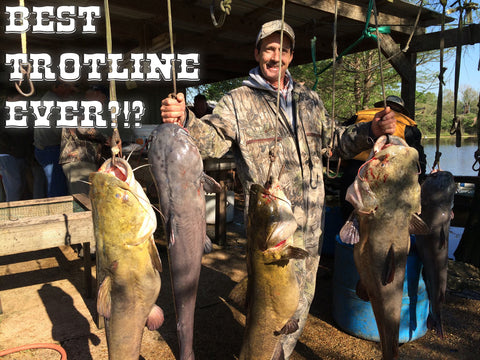
Trotlines for Catfish - The BEST Trotline Ever?!?
Share

I wanted to share something with you guys that has really changed the way my family and I have been running trotlines for catfish. However, before I lay out the design for you… let me say that I realize we all have our preferences on how to do things (especially fishing). Saying that one method is the “absolute best” is like saying one muscle car is better than all the others, or that one type of truck model is the best ever built. You’re never going to get everyone on the same page agreeing on this… and I’m okay with that.
If you have a different method that you think is better; please feel free to share it in the comment section below. The more discussion the better….
Ok, back to the post.
Traditional Trotline for Catfish
For as long as I can recall my family and I have been running trotlines on Lake Sam Rayburn and Toledo Bend (more recently). We have used the traditional design (see image below) which involves tying the trotline off at both ends (usually to a stump), and then sinking the line to the bottom in the middle. We've used this method the majority of my life and have done really well with it.

This is an “old-school” design that was probably used by your great great grandfather if he ran lines. It has literally been around forever, and it works great. However, this design is based off the old assumption that catfish are simply “bottom dwelling scavengers” and not much else. We know this isn’t true (see my last post about the Best Catfish Bait), but we still set our lines out in the same old fashioned way.
Floating Trotline for Catfish ("New Method")
I want to encourage you to try this “new” (it’s not really new... just different) method if you haven’t. It has literally changed the way my stepdad and I fish, and I don’t see going back to the traditional method of running lines anytime soon. This has consistently produced more and LARGER catfish for us. Pretty much all the large catfish pictures you may have seen on our site, Facebook Page, or Instagram have been caught using this method.
Ok, so here’s how to set the line. First check out this basic diagram – I’m obviously no artist, but you’ll get the point.

The obvious difference between this method and the old method is that you will now be floating the hooks and bait. This will have the wind and wave action moving your bait around and helping you to catch more fish. Cool huh?
As for actually setting up your line, you can go as cheap or heavy duty/expensive as you’d like. However, I would strongly recommend that you do the work up front and create a solid-stout line that you can catch those large cats on… because you will be hooking them and nothing is more frustrating than losing those huge fish.
Recommended Supplies for Catfish Trotlines
Here are a few tips for setting up your line:
-
Used HEAVY Line – I recommend using 96 Tarred Nylon which is about 600 lb
test. Pro-Tip… the larger line is thicker and WAY EASIER on your hands when running lines all day. You’ll thank me later.

-
Circle Hooks are a MUST – an instant way to catch a minimum of 20% more fish
per run (even if you don’t use the new trotline model) is to switch to circle hooks. A 6/0 straight hook won’t give you half the holding power that a 6/0 circle hook will provide. They’re that good… and definitely worth the extra cost.

-
Swivels, Swivels, Swivels – Those cheap trotline clips are great for smaller fish and setting quick lines; however if you’re going after large catfish then you need to
be using swivels. These will help to prevent a large fish from getting off the hook by keeping them from tangling the staging line into the main line. I recommend using the 3/0 to 6/0 Swivels as they’re super heavy duty and will last you at least 2-3 years in the water.

- Tight Lines – Get your line as tight as possible before setting the hooks. You can use about 50lbs of cinder (or whatever) on each end and this will do the trick to keep it still. In all honesty, you likely don’t need this much weight as they will sink into the mud and get covered… I just tend to overdo things. = )
- Use Clear Bottles – You don’t need a lot to float your lines. I recommend using clear Gatorade type bottles every 10-20 feet (whatever you prefer) to keep your lines afloat. Using the clear bottles will help to “hide” your line at a distance from folks you don’t want to find it.
- Fish Shallow – Keep your main line about 4 feet below the surface. This will allow boats to pass over the top, but still keep your bait in the hot-zone. This works great for summer months when the water is hot.
Trotlines for Catfish Video
See a video of this trotline method in action below!
Baiting Your Trotline for Catfish
I think that’s about it. I feel confident that if you take the time to set your trotlines for catfish using this method that you will find yourself catching more and larger fish. It’s worked for me, and pretty much everyone I know now uses this method over the traditional one of sinking your lines.
One final thought, and a bit of a selfish plug… you’re going to need good bait to catch fish. If you haven’t checked out our different bait fish traps yet, then please take a minute to check them out here:
Click Image For Info
I sincerely hope that you’ve enjoyed this article and have found at least something useful. If you have, please don’t hesitate to share it on Facebook with your fishing buddies. Thanks for reading, and God bless!


11 comments
I read all of your tips,, ani dare say you gave some great tips that i hope to try out, Thanks. O. T.
Hi Reid! My apologies on missing your comment. I’ve been getting loads of spam on my site, and your comment got buried until I saw it by accident earlier. Sorry about that. Short answer to your question – yes sir, this designed (as it is in this blog post) is mainly a shallow water trotline. You can play around with the depth of your hooks, going from about 4 ft – 6 ft, but I generally don’t go over about 6-7 foot on my lines.
Now this line can be sunk to go across a river, and you can float the line up off the bottom as well. However, that’s a topic for another blog post or video. Long story short, it’s a super versatile line as you can either sink it or float if depending on what you’re wanting to do. Tight lines, man. Thanks for the comment!
Do you set your lines 4 feet below the surface no matter the depth of the water? If the water depth is 7 feet or 15 feet what depth under the surface are the hooks?
This has improved my fishing immensely. I made a small change. I would like to offer a slight improvement, at least how i fish.
I use the swivels on #96 line. I use large 4/0 snap swivels I get off Amazon Then I used #18 braid for the drops and tie then snelled with a loop at the end. This allows me coil up the mainline on an “extention cord reel” without tangles or hooks.
Once my main line is stretched I come back and snap on my circle hook drops. This also allows me to change hook sizes or replace damaged ones with ease.
An added benefit. Since I fish alot by myself, the snelled drop line allows me take the cat off the line without fighting a tough hookset or looking for pliers. I just unsnap the drop line and pick up the cat out of the dip net by the line and toss in the barrel. I add a new hook on the bait up run.
But I have to say, your principal idea here has changed everything. I went from maybe 20lbs to “I need a bigger boat” . I have a guy about a mile up the river that constantly comes down and puts his lines out at my landing. Sometimes even crossing mine. I’ll watch him run his lines and get maybe 3 blues. I’ll have 25-30 averaging 8 to 10 lbs each right next to him!
Does this method work in the river also?